I recently presented at the Singapore chapter of Creative Mornings, an excellent community event that takes place in cities all over the world.
The event's topic that week was 'Risk', so I took the opportunity to explore the different kinds of risk that people working in creative industries face in their day-to-day roles, and how we might go about managing those risks, and hopefully turn them into opportunities.
You can dig into my full presentation in the SlideShare embed above, but read on below for extra context and insight into the 10 themes that we explored on the day.
WHAT IS RISK?
Risk is a word we use in a variety of contexts in our daily lives, so it might help to define what we mean by 'risk' in the context of creative industries:
Risk relates to our inability to predict a certain outcome with a desired level of confidence.
However, given that creativity is - by definition - always about creating something new, risk is an inherent and inevitable part of what we do as 'creatives'.
When we create something new, it's unlikely that we'll be able to predict how the world will react to those creations with any degree of certainty.
In other words, there can be no creativity without risk.
For those working in creative industries, those risks manifest themselves in three broad categories:
- Financial Risk: our inability to predict returns on our investments of money, time, and effort.
- Emotional Risk: our inability to predict how other people - and even how we ourselves - will react to our creations.
- Physical Risk: for those working in certain fields or locations, there are also risks related to our inability to predict how our creative activities will impact our health, safety, or freedom.
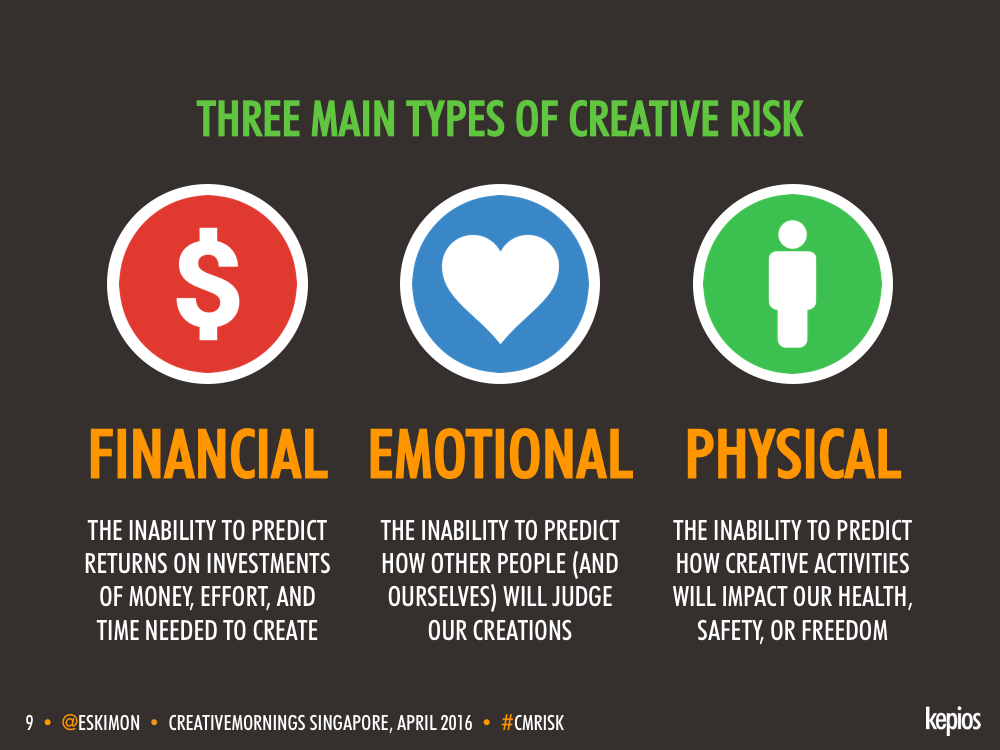
Many of us see these risks as predominantly 'negative' - we focus more on the potential for loss, without stopping to think that risk often works both ways. But taking carefully measured risks can actually help us to achieve unexpected gains, just as they may lead to undesirable losses.
Even in those situations where we don't achieve the outcomes we hoped for, though, we'll often learn valuable lessons in the process that enable us to avoid similar risks in the future, and identify new or better ways to succeed.
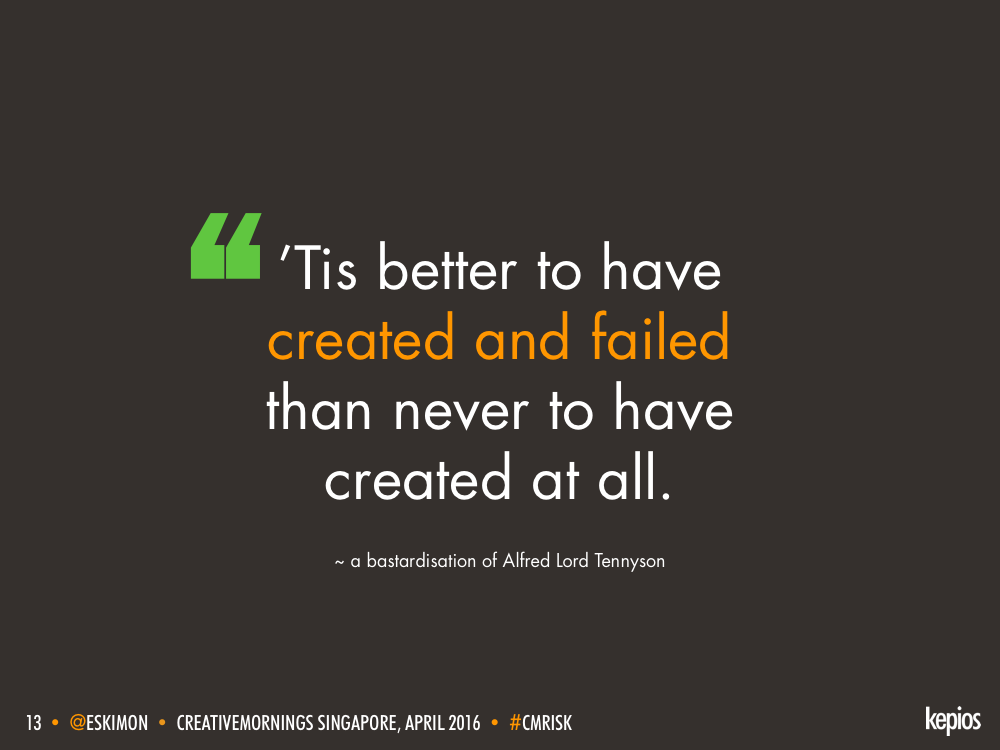
However, most of us would prefer to create and succeed, rather than create and fail. So how do we tip the balance in our favour, and achieve more of what we want with fewer downsides?
The simplest way to improve our chances is to take a measured approach to risk mitigation, which we can do in three simple steps:
- First, we need to identify what kinds of risk we may face.
- Second, we need to understand how those risks might impact us (for better and for worse).
- Lastly, we need to actively manage those risks, in order to maximise our chances of success.
To help make sense of those 3 steps, I devised a simple framework - The 10 Cs Of Creative Risk - that sets out some of the most common risks creative people will face in their daily work:
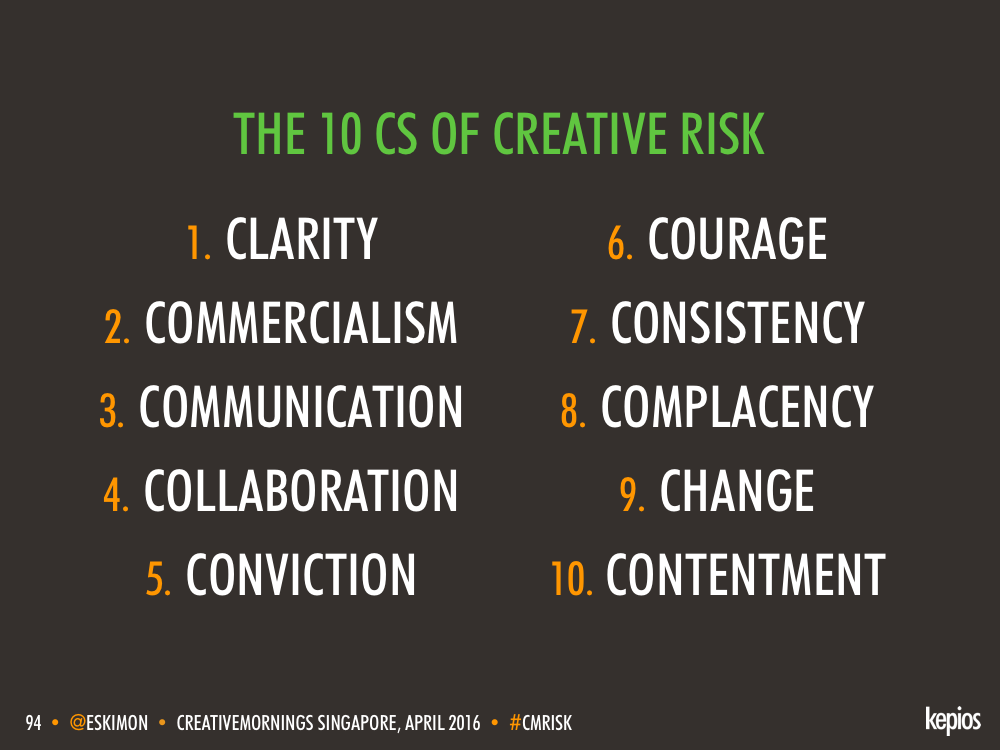
The rest of this post explores each of those 10Cs in detail. Note that I'll use the word 'client' frequently as we go, but - depending on your own context - you could just as easily use the words employer, partners, teammates, boss, internal stakeholders, shareholders, or even regulator in its place.
1. CLARITY
Risks associated with a lack of direction
It's much harder to succeed if you don't know what success looks like to begin with. A lack of clear objectives is one of the most common causes of creative 'failure', but it's also one of the easiest to address.
What are you trying to achieve?
It's important to ask yourself this question from a purely personal perspective - even before you think about what your client, employer or teammates might want - and to ask it of yourself on a regular basis.
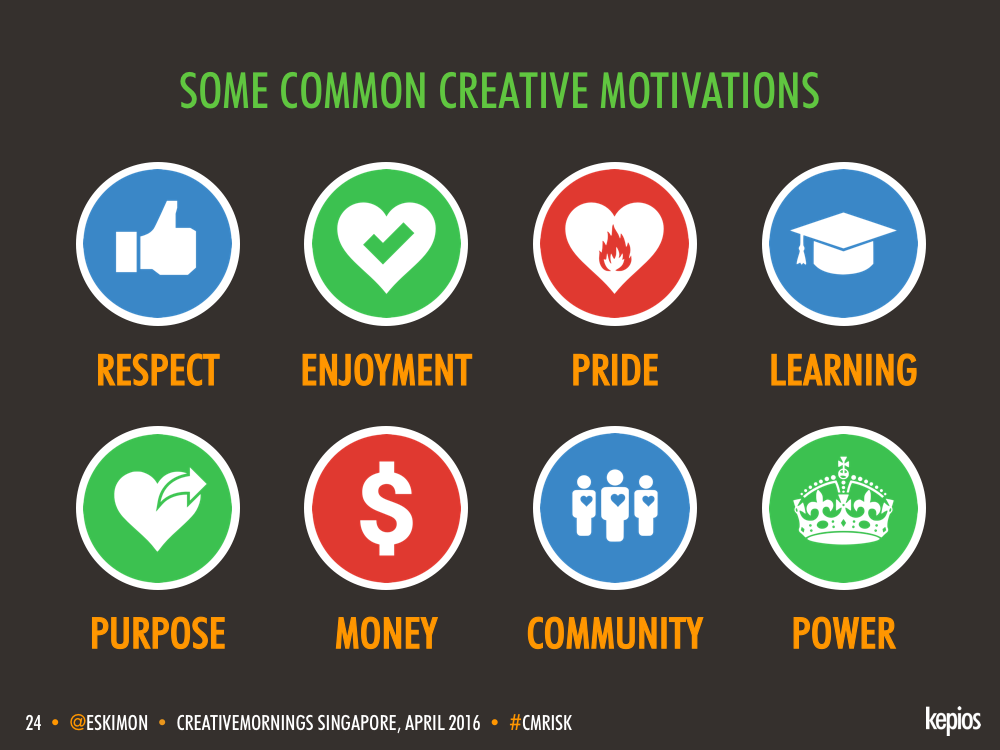
Understanding your own motivations is the first step towards getting what you want, and it will play an important part in helping you to avoid unnecessary risks relating to wasting your own time, effort, money, and emotion.
We need to be honest with ourselves, though; it's often easy to get distracted by what we think the correct answer should be - in other words, to chase someone else's definitions of happiness and success, rather than taking time to understand our own dreams and ambitions.
As part of this, it's helpful to set yourself some goals and milestones too. Where do you want to be 12 months, 5 years, and 25 years from now? What do you hope to have achieved before you retire?
What does success look like for you? Knowing your purpose will help you to achieve it.
2. COMMERCIALISM
Risks associated with not understanding the role of a creative professional.
Another important challenge is knowing how you'll fund your activities and lifestyle between now and success.
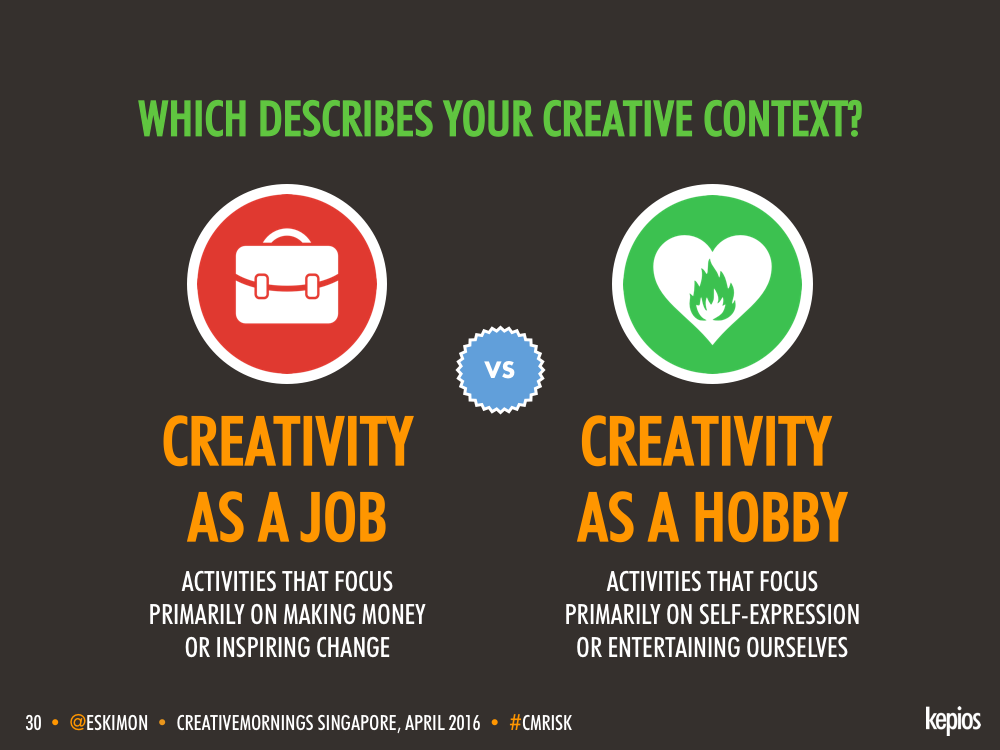
If you rely on creativity to fund your livelihood, it's clear that you're going to need to adopt a more commercially minded approach. This invariably means using your creative skills to help other people achieve their objectives too, but this is where many creative professionals trip up: they mistake their clients or employers for rich benefactors, rather than recognising them as other individuals with their own goals, ambitions, and dreams (just like their own).
The simplest way to mitigate commercial creative risks is to understand that creativity is a means to an end; much as it may pain us, what our creations do is ultimately more important than what they are.
Central to this is recognising the distinction between 'outcomes' and 'outputs': we need to identify and understand the change that our creations must deliver on behalf of those who pay for our work.
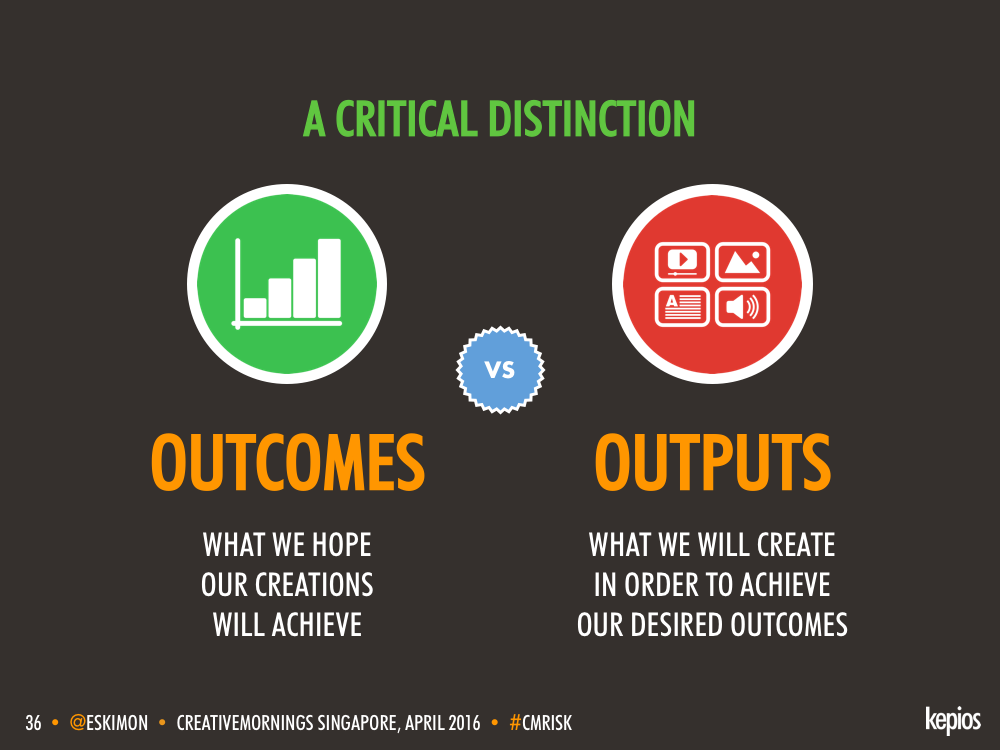
3. COMMUNICATION
Risks associated with failing to understand clients' needs and expectations.
One of the main reasons creative professionals struggle with Commercial risks is that they fail to align with their clients on a shared definition of success. However, if you don't know what your client wants to achieve, you're making things far more difficult for yourself, and for those you're working with or for too.
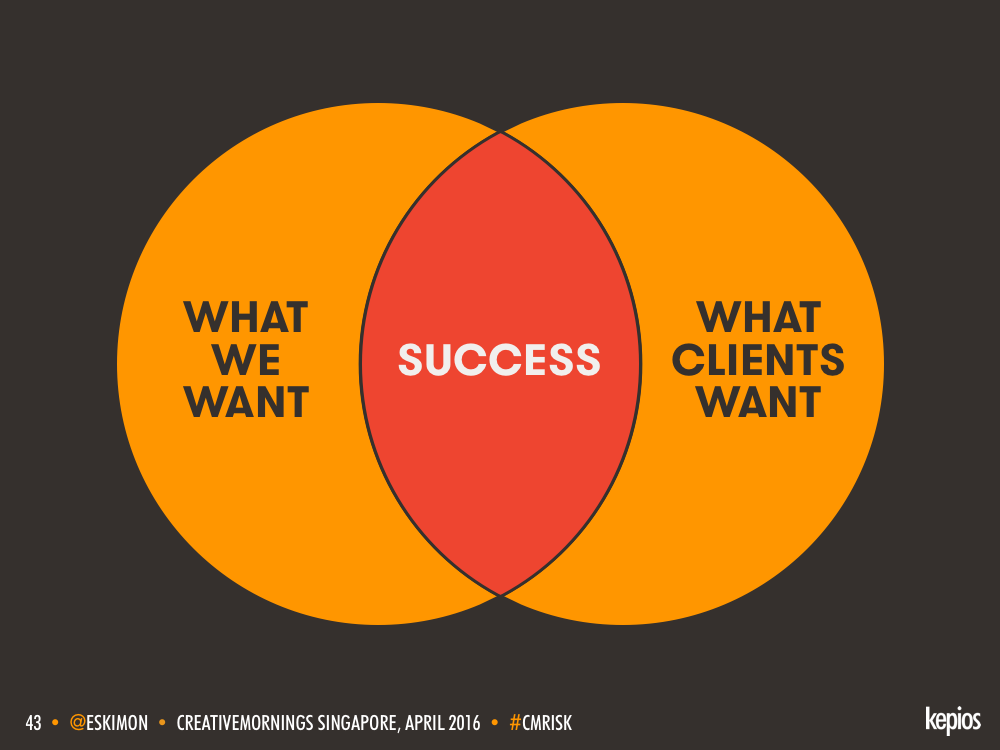
Similarly, before we invest any serious time, effort, or resource in creating something for our clients, it's wise to take some time to understand each of your clients' 'appetite' for risk (the same goes for employers, partner, teammates, etc.).
Knowing how much creative 'stretch' clients can - and will - tolerate is a hugely important step in developing an enduring and mutually respectful relationship with clients, but most creative professionals never undertake this alignment process.
This is a topic that merits deeper exploration, so I've written a detailed introduction to 'creative risk profiling' on the Contagious blog - you can read the whole thing for free by clicking here.
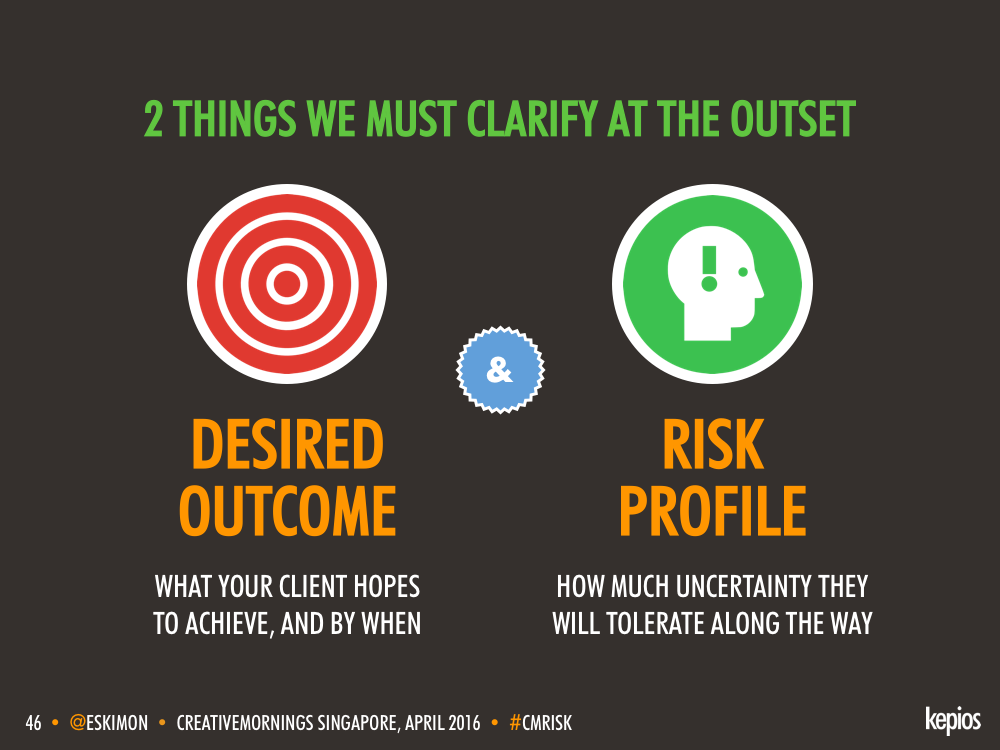
4. COLLABORATION
Risks associated with not involving other people in the creative process It's likely that your creative risk profiling exercises will reveal that your clients' appetite for creative risk does not match your own.
This is to be expected, of course, but in order to address this misalignment, it's up to us as creative professionals to ensure that our creative approach does not alienate our clients.
The simplest way to prevent this mismatch from becoming an issue is to ensure that you take clients along your creative journey with you.
Many creative professionals find this difficult, though; it's common for 'creative types' to prefer working alone, and to only share ideas or work when it's 'finished' (which, for most of us, only happens when we reach the client's final deadline). This is a risky strategy for us, though.
Firstly, by the time we've produced a fully worked-up idea, we've typically become quite emotionally attached to it, which makes receiving critical feedback more difficult. Secondly, by perfecting our initial ideas right up until the deadline, we usually don't allow ourselves sufficient time for revisions, which leads to last-minute stress (and late nights) for us, and frustration and stress for our clients.
Most importantly though, we need to remember that we're producing this work on behalf of our clients. It's imperative that we deliver creative work that we believe in and that we're proud of, but - ultimately - the client's opinion and satisfaction are more important than our own; after all, they're the ones paying for our time and effort.
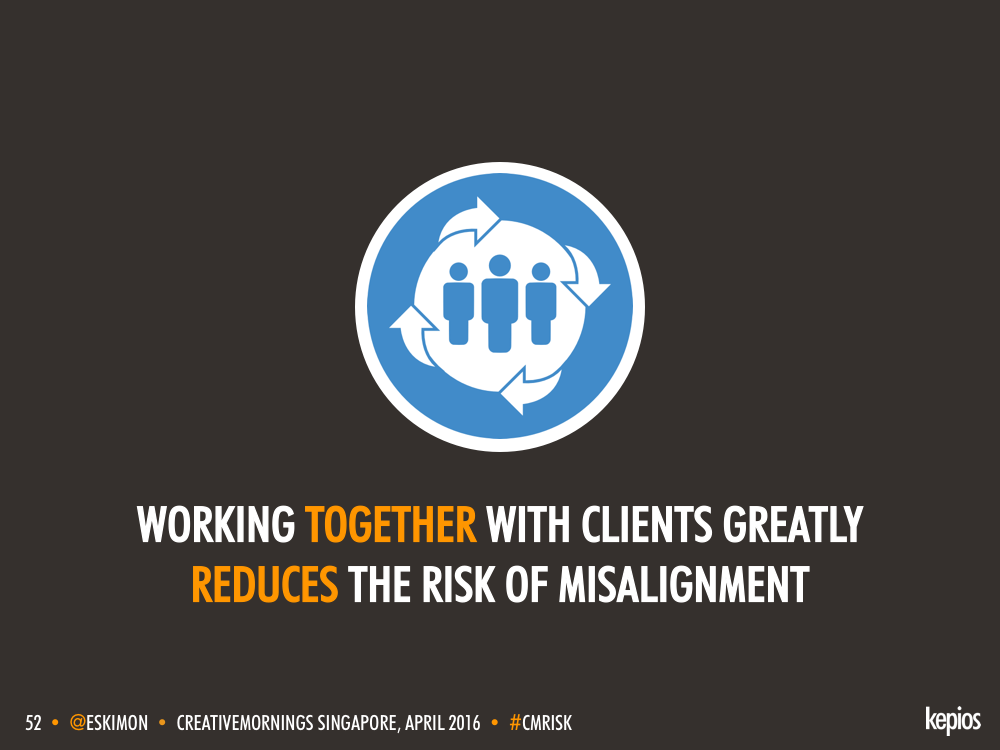
By sharing our ideas earlier, more openly, and more frequently with our clients, we can better manage their potential fears and levels of (in)tolerance for risk.
But sometimes, even frequent sharing won't be enough to get past differences of opinion. In situations where you can't reach agreement, some kind of compromise is invariably the best answer, but it's important to recognise that there will be times when compromise is either the wrong choice, or it's technically impossible.
In such situations, we either need to walk away from the client engagement - which is obviously less than ideal - or we need to find a way to persuade our clients to trust our advice and counsel. The important question here, of course, is how?…
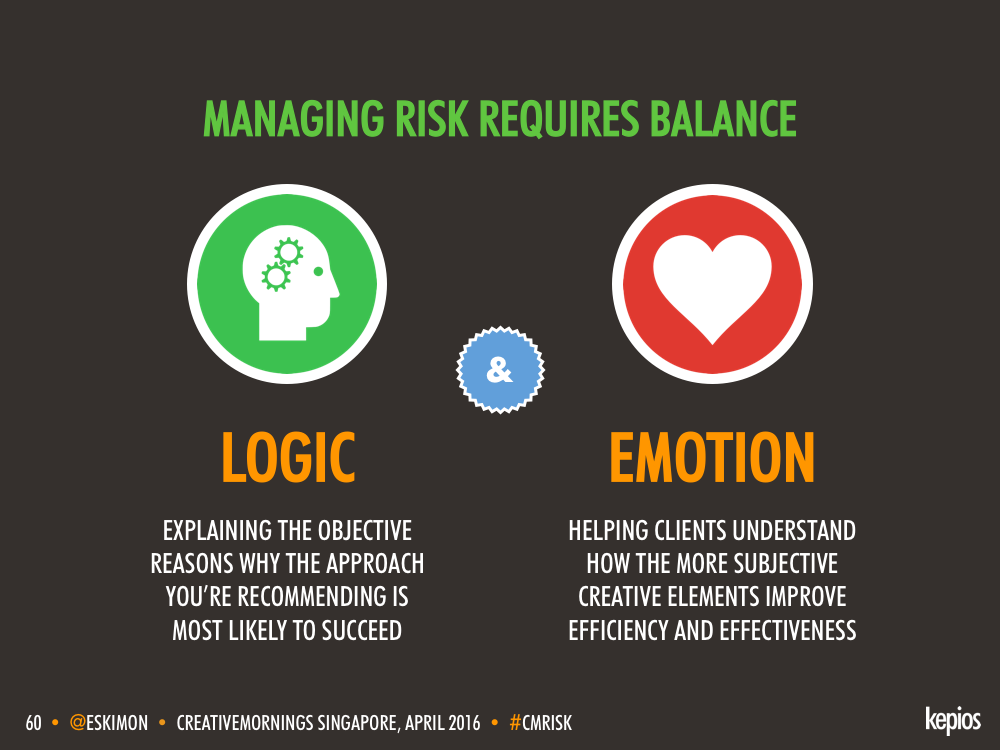
5. CONVICTION
Risks associated with our own lack of self-belief.
The most important part of convincing clients is to genuinely believe in the ideas and solutions you're recommending in the first place.
However, compelling self-belief will only work if you can demonstrate that you truly understand your client's challenges and context, and help them to understand why you believe that your proposed approach is the optimum way to address them.
As Jason Fox says,
"The art of compromise is knowing when not to."
But, critically, in situations where you're struggling to find a suitable compromise, you will need more than subjective declarations of superior taste and style. Much as this should seem obvious, it's worth stressing that 'having a creative tantrum' is unlikely to deliver the results you're hoping for, and worse still, behaving like a creative diva is only likely to further exasperate your client.
The first step to overcoming misalignment is to demonstrate empathy; show that you understand why the client isn't convinced - based on their needs and feedback - before offering your perspective.
Then, when you move on to setting out the arguments for your ideas and solutions, make sure that you balance both logic and emotion; offer objective reasons why your proposal will help address your client's brief, as well as more subjective reasons that back up the aesthetic approach you're advocating.
6. COURAGE
Risks associated with a lack of enduring bravery It's not just our clients' creative stresses that can limit our success, though.
Creativity requires us to try new things all the time - and then to be judged on those creations.
As many creative professionals will attest, the need to come up with new ideas every day can be both physically and emotionally exhausting. There may be times when we're tempted to resort to 'recycling' (or even stealing) old ideas, but this runs counter to our role as 'creative'.
Similarly, we may also fall victim to our own self-censorship or self-censuring behaviour. In almost every creative endeavour, there will be times when we question whether our own ideas are as good as we first thought, and whether the world will receive them in the ways we hope.
It's important to explore these doubts, of course, because they're a critical part of perfecting our creations and ensuring that we develop the best possible outcomes and outputs.
However, we also need to recognise that these doubts may also result from the creative equivalent of 'snow blindness' - the inability to see and think clearly as a result of looking at (or thinking about) the same idea for too long. It's vital to remember that this doesn't mean our idea is wrong; it usually just means we need to take a break, and revisit the idea later, with fresh eyes a clear mind.
7. CONSISTENCY
Risks associated with a lack of determination
There are two ways to achieve what you want: luck, or hard work.
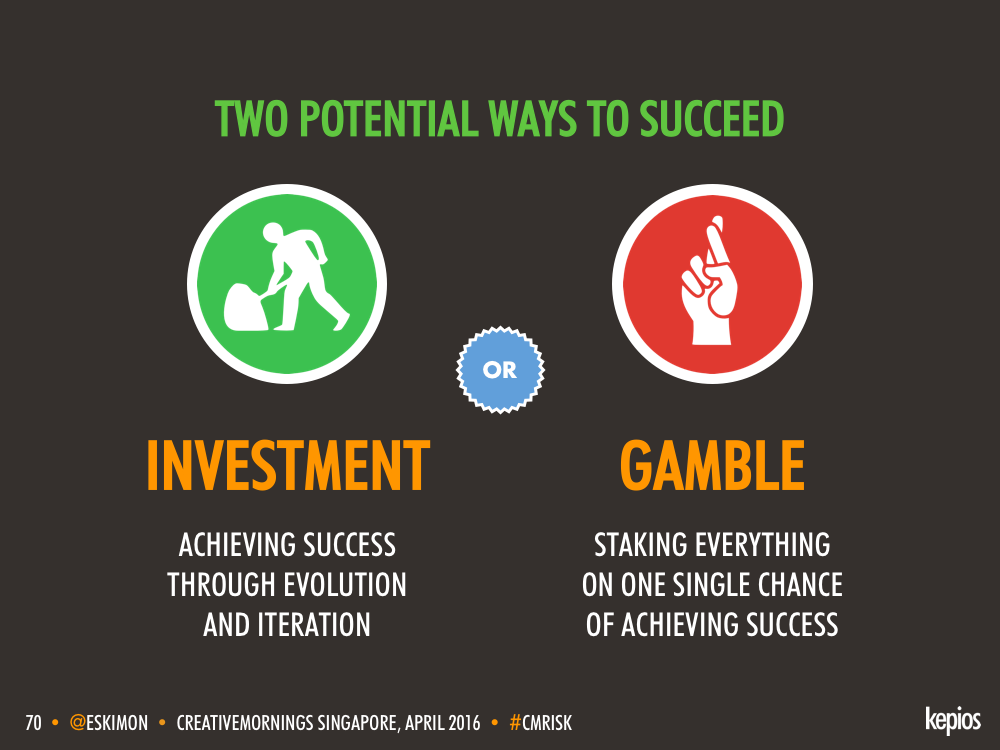
However, life-changing luck is rare, and more importantly, it's unpredictable. If you're gambling on luck to be your saviour, you can never be sure when that gamble may pay off - or indeed, if it will ever pay off at all.
We can all point to stories of 'overnight success', but in reality, we're usually just unaware of the hard graft that people put in before we heard of their success. Most celebrated billionaires in their twenties have still invested disproportionate time and effort in order to succeed, and it's that investment that has helped them succeed - not some quirk of fate.
And, just like financial investments, we're likely to see better results the sooner we start putting in the time and effort required to achieve the things we care about. As Woody Allen points out,
"80% of success is just turning up"
His words don't mean that success is as easy as just showing up and waiting for magic to happen, though; rather, he's pointing out that so few people even bother to try, that simply trying is the most important determinant of success.
But, to continue Allen's assertion, what constitutes the remaining 20%?
The answer is commitment: the willingness to keep turning up, again and again - regardless of how inspired you feel, or how tough the work seems, or how bad the weather is - and making success come to life.
And this is where we need to challenge one of the greatest fallacies of current business thinking: 'fail faster'.
It's a phrase we hear again and again, from those same twenty-something billionaires, or the latest tech startup, or even revered business leaders.
But 'fail faster' is utter nonsense.
We only 'fail' if we give up.
A child who still hasn't learnt how to tie his shoelaces hasn't failed; he's merely not learnt how to do it yet. But each time he doesn't succeed, he has the opportunity to learn from what didn't work last time, refine his approach, and perhaps succeed the next time.
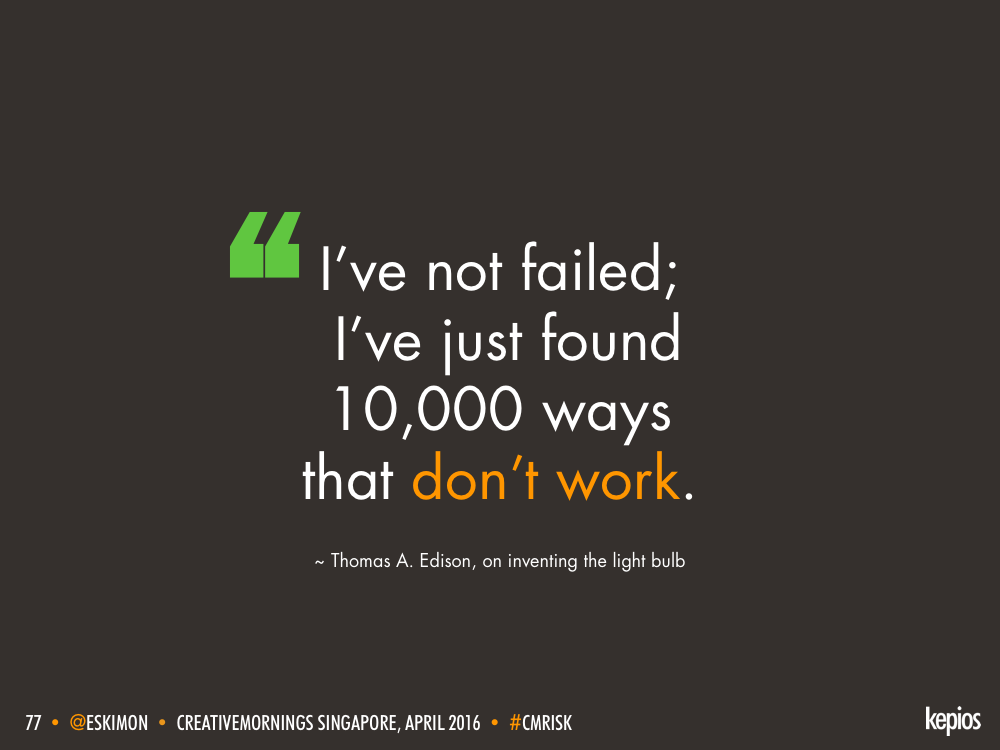
The real secret to enduring success is to learn faster - to examine why we didn't succeed last time, and identify what we might do differently next time to improve our chances of success. However, it's also important to re-explore our definition of success from time to time, to ensure that the dreams and ambitions we're chasing are still the most valuable use of our time, effort, and resources.
8. COMPLACENCY
Risks associated with arrogance, or an overly inward focus.
Regardless of how much we believe in our cause or what we're doing, there's always a danger that the world around us changes in ways that leave us behind.
Developments such as new technologies can quickly disrupt the value that our creativity was supposed to deliver, often through no fault of our own:
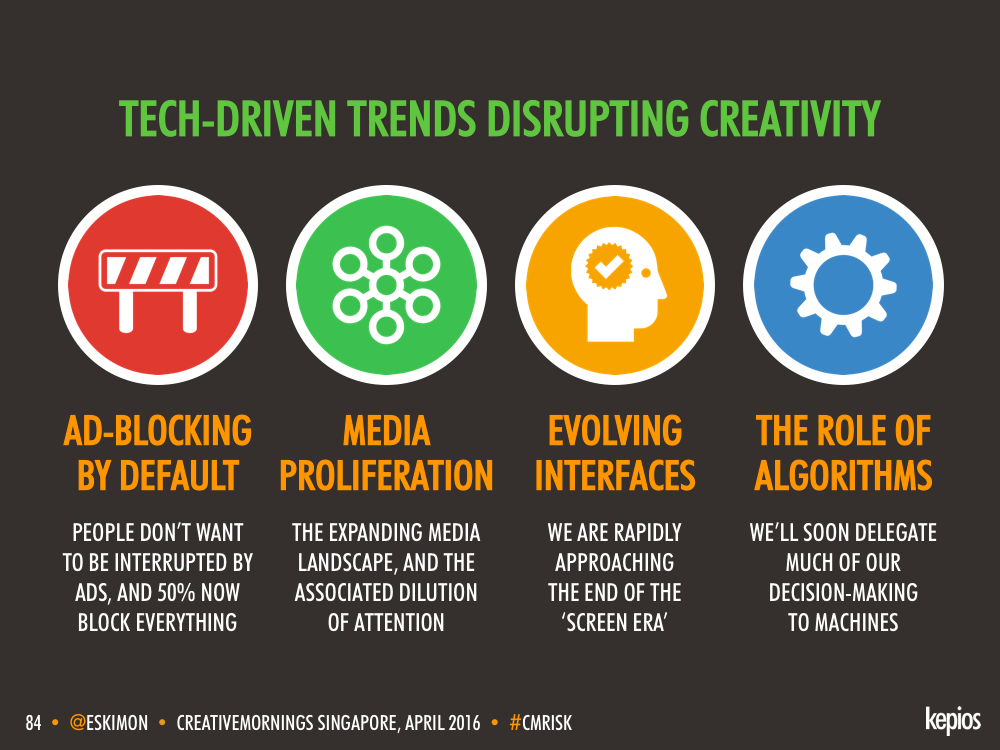
Similarly, changes in fashion and people's tastes can dramatically alter the way other people view our creations, so it's important for us to keep a watchful eye on external developments to ensure that our creations remain as relevant and as valuable as we'd like.
However, changes in technology, fashion, and tastes can also present us with new creative opportunities, so it's important to keep an open mind and explore potential ways in which these developments might offer us more efficient, more effective, or more exciting ways to deliver our creative ideas.
9. CHANGE
Risks associated with not evolving.
Creativity is all about producing something that's never been done before, so creativity is inherently about embracing change.
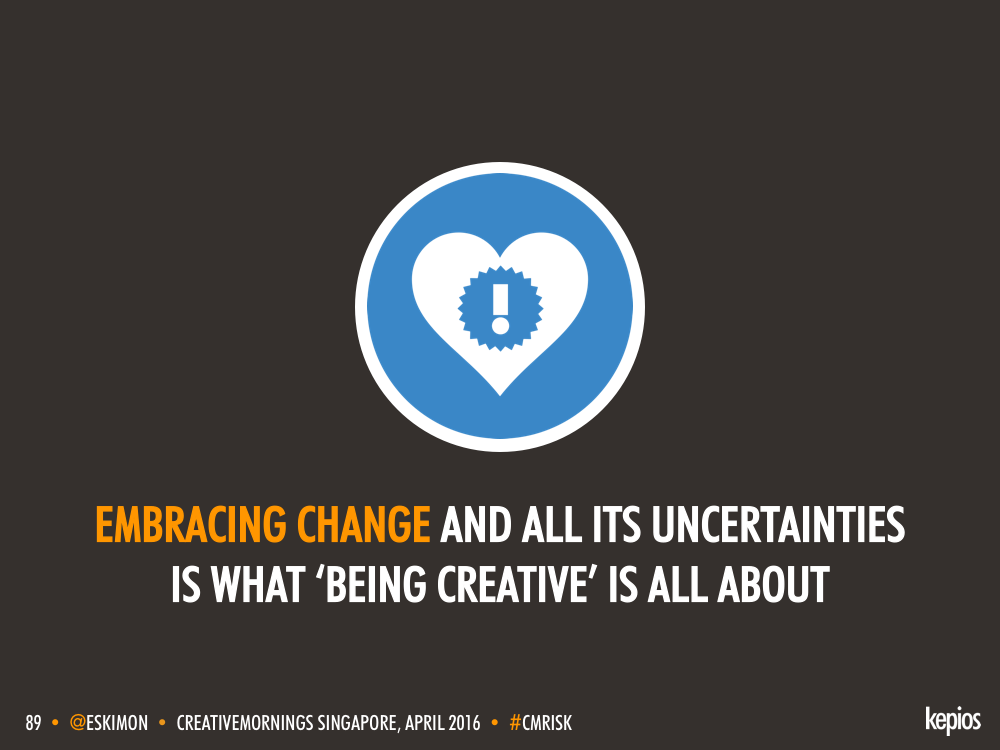
This change can just as equally apply to you too, though, and it's important for creative professionals to constantly explore new ways to satisfy their motivations and find new avenues to achieve their objectives.
It's also worth re-evaluating your objectives every so often as well, just in case those have changed too; there's nothing wrong in changing direction half-way through a journey if you find a new path that you'd rather be on.
Indeed, by continuing to evolve throughout your creative career journey, you're far more likely to achieve the elusive tenth 'C'…
10. CONTENTMENT
Risks associated with not enjoying what you do.
There will be times in every creative career when we get tired, when we question what we're doing, or when we feel like we've simply had enough. If you're having more of those days than you'd like - if you're waking up on Monday mornings and dreading the idea of another day of work - the it's probably time to go back to the first 'C', and plan out a new journey.
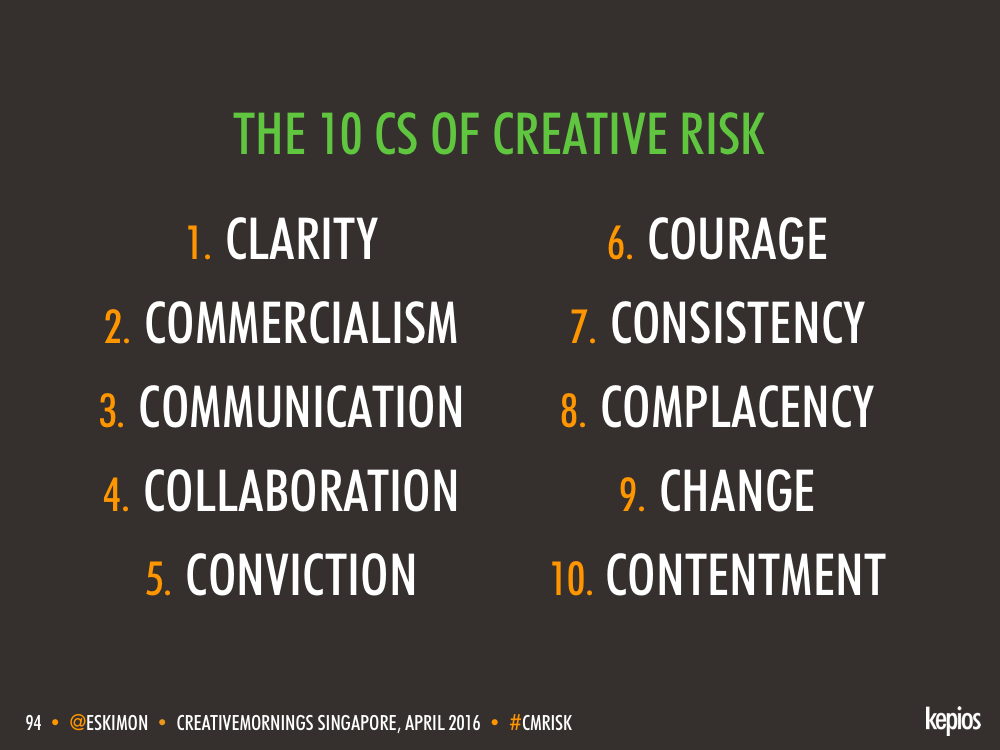
CONCLUSIONS
If you've chosen a creative path from the outset, you'll need to build that path for yourself as you go; if you're following in someone else's footsteps, you're not being creative, and you're not living up to your full potential.
Creativity is supposed to be uncomfortable.
It's supposed to be hard work, and it's supposed to leave you feeling uncertain and vulnerable.
You're unlikely to get it 'right' first time, and you're even less likely to get it right every time.
It's even questionable whether there is such a thing as 'right' when it comes to creativity.
What really matters is that you feel you're creating something of value, and that you're enjoying the journey as you go.
This post first appeared on Simon's LinkedIn here.